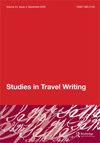The visitors’ book in historical context: introduction
Q2 Arts and Humanities
引用次数: 0
Abstract
It is customary to begin introductions such as these with remarks underscoring the relative newness of research in the field. Thatmay be the case here, though the argument in favour of this collection is as much that it brings together scholars who have beenworking on discrete projects centred on a specific source set – one whose value has often primarily been understood in terms of the nominal information it yields about travel markets. Broadly speaking, the contributions in this issue explore the visitors’ books’ relationship to other texts, contemporaneous and historical, manuscript and print; their role in record-linkage; and their communicative functions amongst a range of users. All articles underscore that these sources have real research value; by asserting their value as forms of travel writing in particular, the authors argue in favour of materials that might otherwise be regarded with the same curiosity and dismissiveness that attended evaluations of the sources in the nineteenth century. Initial interest in the books for the systematic exploration of the geographic compass of the client market has given way, as this issue attests, to examinations of these sources as literary and cultural artefacts. The books tell us a great deal about technologies of transport, as several contributions to this issue underline, but also of the book itself as a technology – as an instrument for organising and communicating data, and not merely narrowly-defined nominal data. Perhaps themost obvious comment tomakeon these sources is that their survival is largely serendipitous: the articles that follow explore visitors’ books held in local museums, private establishments, libraries, county archives and other record repositories. Others were privately acquired and are held outside public archives and institutions. Perhaps more than anything this has nourished assessments of their ephemeral character – a stance which, until the embrace of ephemera as the basis for serious scholarly inquiry, left them to languish with the other “fragmentary documents of everyday life”, to borrowMaurice Rickard’s terminology (2000). Adding to their ambiguous status as James andNorthey note in this volume, and as all contributions here underline, is the diversity of material structures that the “visitors’ book” encompassed, to say nothing of related nomenclature, from French “livres d’or”, “registres des arrivées” and “livres des étrangers” to German “Fremdenbücher” and many other similar variations. Serving in places as an album, elsewhere as a register, often as both at once, the artefact is difficult to define, and its genealogies remain largely apocryphal. To understand the evolution of the visitors’ book’s value as an historical source, it is important to recognise how it was configured within meta-narratives that explicated历史语境下的游客之书:导论
按照惯例,在这样的介绍开始时,要强调该领域研究的相对新颖性。这里的情况可能是这样的,尽管支持这一集合的论点是,它将一直致力于以特定来源集为中心的离散项目的学者聚集在一起,而这些来源集的价值通常主要是根据它产生的关于旅游市场的名义信息来理解的。从广义上讲,本期的贡献探讨了访客书籍与其他文本、同期与历史、手稿与印刷品的关系;它们在记录链接中的作用;以及它们在一系列用户之间的交流功能。所有文章都强调,这些来源具有真正的研究价值;通过特别强调它们作为旅行写作形式的价值,作者们主张使用那些可能会被视为与19世纪对来源的评估一样好奇和不屑一顾的材料。正如本期所证明的那样,最初对系统探索客户市场地理罗盘的书籍的兴趣已经让位于对这些来源作为文学和文化艺术品的研究。正如对这一问题的几项贡献所强调的那样,这些书告诉了我们很多关于运输技术的内容,但也告诉了我们这本书本身是一种技术——一种组织和交流数据的工具,而不仅仅是狭义的名义数据。也许对这些来源最明显的评论是,它们的生存在很大程度上是偶然的:下面的文章探讨了当地博物馆、私人机构、图书馆、县档案馆和其他记录库中的游客书籍。其他则是私人收购的,存放在公共档案馆和机构之外。也许最重要的是,这滋养了对他们短暂性的评估——根据莫里斯·里卡德(Maurice Rickard)的术语(2000),这种立场直到将短暂性作为严肃学术研究的基础,才让他们与其他“日常生活的零碎文件”一起备受煎熬。正如詹姆斯和诺西在本卷中所指出的,以及这里所有的贡献所强调的那样,“访客之书”所包含的物质结构的多样性,更不用说相关的命名法了,从法语“livres d'or”,“registres des arrivées”和“livres desétrangers”到德语“Fremdenbücher”和许多其他类似的变体。在一些地方作为专辑,在其他地方作为登记册,通常同时作为两者,这件艺术品很难定义,其家谱在很大程度上仍然是伪造的。为了理解访客书籍作为历史来源的价值演变,重要的是要认识到它是如何在元叙事中配置的
本文章由计算机程序翻译,如有差异,请以英文原文为准。
求助全文
约1分钟内获得全文
求助全文
来源期刊

Studies in Travel Writing
Arts and Humanities-Literature and Literary Theory
CiteScore
0.40
自引率
0.00%
发文量
13
期刊介绍:
Founded in 1997 by Tim Youngs, Studies in Travel Writing is an international, refereed journal dedicated to research on travel texts and to scholarly approaches to them. Unrestricted by period or region of study, the journal allows for specific contexts of travel writing to be established and for the application of a range of scholarly and critical approaches. It welcomes contributions from within, between or across academic disciplines; from senior scholars and from those at the start of their careers. It also publishes original interviews with travel writers, special themed issues, and book reviews.
 求助内容:
求助内容: 应助结果提醒方式:
应助结果提醒方式:


